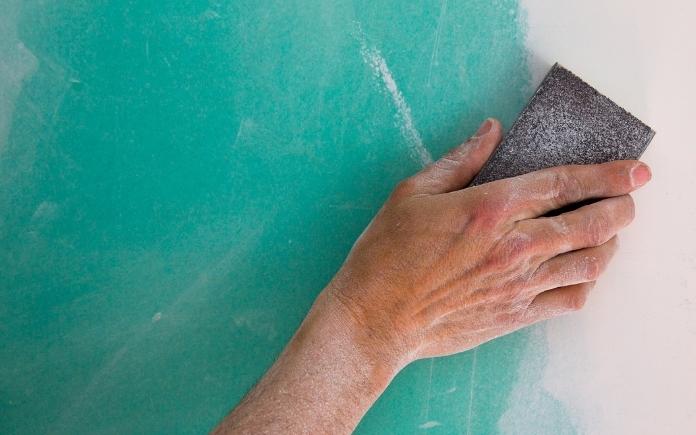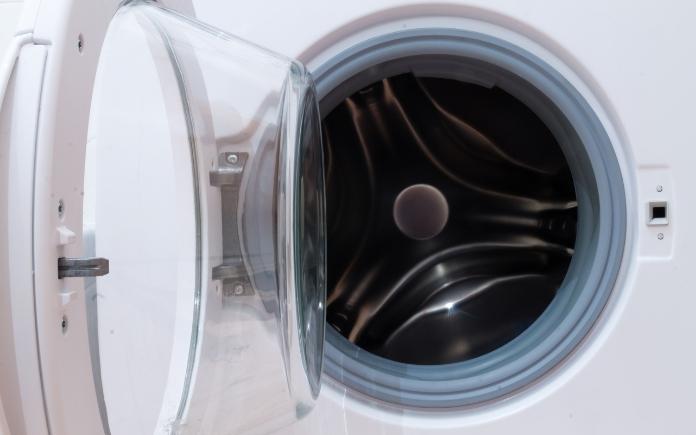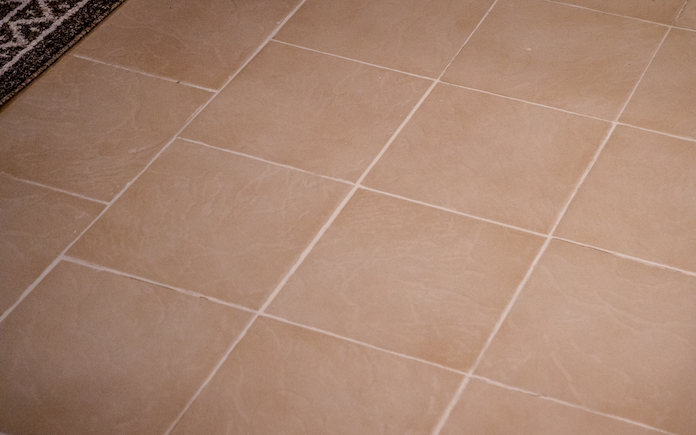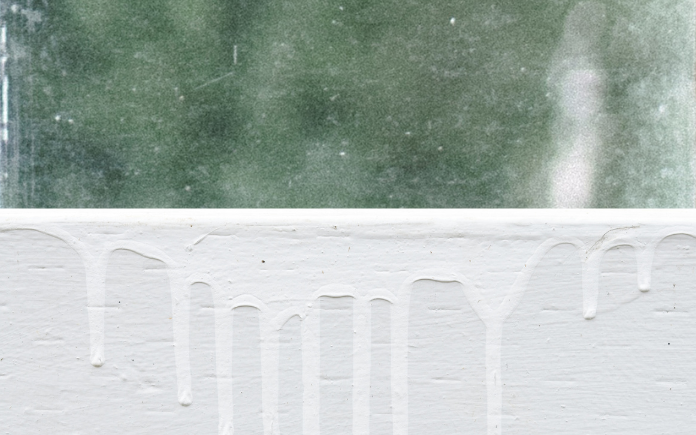Table of Contents

Hour 1
In Hour 1, learn how to repair drywall cracks, eliminate funky front-loading washer odor and more.
Repairing Cracked Drywall

Lisa Baker in Columbus, Mo., owns a two-story house with a fully finished basement, and she’s noticed small horizontal cracks along a few drywall seams.
“I understand that this is from the house settling. What’s the easiest way to fix these cracks?” she asks.
If your house is “settling,” it doesn’t necessarily mean the structure is dropping. This could just be some minor expansion and contraction. If you have uneven settling, it usually results in a vertical crack, and it may indicate structural damage. Call a foundation specialist if:
- The crack has a 3/16-inch or wider gap.
- One side of the wall is higher than the other.
- Your doors no longer close in the frame.
In Lisa’s case, the drywall was most likely installed horizontally, so that’s why the cracks are forming in that direction.
Assuming the drywall tape is still in place, lightly sand the cracks, vacuum off all the dust and apply a thin coat of joint compound. Do this in a small area first to make sure this corrects the problem.
If the tape is peeling, adhere it back to the wall with some glue or joint compound. If that doesn’t work, you’ll have to remove the tape and apply new.
First, apply joint compound and cover the crack with paper drywall tape pressed into the wet compound. Then cover the tape with more joint compound, and allow it to dry before sanding.
Watch How to Repair Cracks and Dents in Drywall for more information.
Funky Washer Odor

Joanne Polley in Columbus, Ohio is fed up with the funky smell coming from her front-loading washer.
“Why did that happen and how can I clean it so it’s fresh-smelling again? I never had this problem with my old top loader,” she says.
Unlike a top loader, the door on a front loading washer stays wet. Mold, mildew and detergent build up and lead to that funky odor.
Read: How to Remove Mold and Mildew From Front-Load Washing Machines
It’s an easy fix, but it’s can be tedious. After every load, use a towel to dry the inside of the door and the rubber gasket. This removes the moisture, preventing mold and mildew from growing and emitting that awful smell.
Keep the door open for a while to let the air circulate inside the washer. Keep an eye on children and pets when you do this because they can easily climb inside.
For good measure, run an empty load with a cup of bleach every three to four months to disinfect the entire washer drum.
Restoring White Grout

Suzanne Lewis in Wilmington, N.C. says, “I have off-white tile in my bathroom with off-white grout. The grout is beginning to discolor to a more brown color. What do you suggest to clean the grout?”
If grout isn’t sealed properly when it’s installed, it will eventually become discolored. You can restore the grout to its original color and prevent the stains from returning. Here’s how:
- Mix a 50-50 solution of oxygen bleach and hot water. It’s important to use hot water for the oxygen bleach to dissolve.
- Apply it to the grout joints with a sponge and wait 10 minutes.
- Soak the grout one more time with more bleach solution and wait another 10 minutes.
- Scrub the grout and rinse it with clean water.
Once the stains are gone, cover the grout with a clear silicone sealer. Use an artist’s brush to fill in every single grout joint.
Hour 2
In Hour 2, hear how to get rid of goathead weed stickers, open a window that’s painted shut and more.
Getting Rid of Goathead Weed

Christie Svoger in Oregon has a sticky problem on her lawn.
Her lawn is covered in goathead weed stickers. Goathead weed, or puncturevine, is an invasive toxic plant. The spines on its fruit are sharp enough to puncture bicycle tires and shoes, according to Washington State’s Noxious Weed Control Board.
“How do I get rid of them? I don’t want them on my lawn!” she asks.
Hand-pulling goat’s head weed won’t be effective because they have such a strong root system and will grow right back. Use a tool like a weed puller to get down deep to remove the roots.
You’ll have to take some extra measures to ensure it won’t return. Use a strong pre-emergent weed herbicide or try this home remedy: dilute 1/2 cup each of Epsom salts and vinegar in a gallon of water and spray thoroughly.
Another effective method is to use a weed-burning propane torch. Just be sure to check your local laws regarding the use of these devices and have a fire extinguisher nearby.
A one-time treatment won’t work, so be vigilant in killing it when more pop up.
Fixing a Window That’s Painted Shut

The windows in Bob Haskins’s home in Medford, Mass., appear to have been given the “landlord special” treatment. They’re painted shut and are impossible to open.
The term “landlord special” has become popular with renters who are referring to bad home improvement projects often done by landlords instead of professionals to save money.
Typical examples of the “landlord special” are painted-over electrical outlets and windows, shoddy plumbing or odd “fixes” that don’t really improve anything.
“How can I break them loose without breaking the window?” Bob asks.
First, be very careful working around glass and take your time. Wear eye protection and gloves, and if you’re on a ladder, practice the recommended safety measures.
Think about what’s holding the window shut: paint residue all around the perimeter. Use a thin-bladed putty knife to break the seal on the inside and the outside. Do it carefully and you’ll find the point where the window sash goes up against the molding or trim.
Slide the putty knife down the side, bottom and all the way around the window to where the two sashes meet together. Then, cut the paint out. Take your time and try to eliminate any contact points.
Next, take a flat bar and pry up the window. Don’t put too much pressure on one side or the other. Even pressure will lessen the chance of the window cracking.
In the Aisles of The Home Depot

Fire can strike anywhere, anytime, and can start in a variety of ways. Fire safety equipment such as fire extinguishers, smoke detectors and carbon monoxide detectors, are essential must-have products for any home. The Home Depot has all different types of fire safety equipment plus other important fire safety tips for protecting your family and home.
Fire Education
Have a plan in place to keep you and your loved ones safe. Establishing a family fire escape plan will encourage everyone to remember a safe meeting spot outside of your home.
You and your family should practice a fire escape plan twice a year. Everyone should know how to get out and where to go in case of a fire.
Practice fire drills together and make sure children know what the smoke alarm sounds like and what to do when they hear one.
Fire Extinguishers
The first and most important thing to always have in the home, especially when cooking or gathering around a fire pit or enjoying a fireplace is a fire extinguisher like the Kidde Full Home Fire Extinguisher with Hose, Easy Mount Bracket & Strap, 3-A:40-B:C, Dry Chemical, One-Time Use.
For smaller spaces, consider the Kidde Basic Use Fire Extinguisher with Easy Mount Bracket & Strap, 1-A:10-B:C, Dry Chemical, One-Time Use.
A fire extinguisher can be lifesaving when water cannot put out a fire, as is the case with most kitchen fires. Having a fire extinguisher within reach can help put out small, contained fires and create a path to safety.
Never rely solely on a fire extinguisher. This tool should be just one part of your home fire safety plan, alongside smoke alarms and an emergency evacuation plan.
Fire extinguishers are classified by ratings of A, B, C and D. These ratings determine the size and type of fire that the extinguisher can put out. Do your research to determine which is best for your needs. Some fire extinguishers are multi-purpose and have two or more ratings, such as A-B or A-B-C. Generally, multi-purpose fire extinguishers are the best types of fire extinguishers for the home.
- Class A fires are a result of trash, wood, or paper.
- Class B fires are a result of liquids or gases.
- Class C fires are caused by energized electrical equipment
- Class D fires are caused by combustible metals – due to their severe nature, class D fires are best handled by professional firefighters.
When using a fire extinguisher, remember the PASS method to operate the extinguisher properly:
- Pull the pin.
- Aim the nozzle toward the base of the fire.
- Squeeze the lever slowly.
- Sweep the nozzle from side-to-side, while moving toward the fire.
Smoke Alarms
Smoke alarms are a safety essential for every home.
Exclusively available at The Home Depot, the Kidde 10-Year Worry Free Smoke & Carbon Monoxide Detector, Lithium Battery Powered with Photoelectric Sensor and Voice Alarm which detects both smoke and carbon monoxide with just one device.
For new builds, check out the Kidde Hardwired Smart Smoke and Carbon Monoxide Detector with Indoor Air Quality Monitor, 10-Year Lithium Backup Battery.
When placing your smoke alarm, it is important to have at least one smoke alarm on every level of the home (including basements), in every bedroom, and outside each sleeping area.
Test monthly and use daylight savings time as a reminder to install new batteries in smoke detectors.
Carbon Monoxide (CO) Monitors
Every home with at least one fuel-burning appliance, attached garage or fireplace should have carbon monoxide alarms.
Having a fireplace with a gas valve or a potentially blocked chimney poses a risk for carbon monoxide (CO) poisoning, so include CO monitors in your fire safety equipment, especially since CO is undetectable via smell or sight.
Just like a smoke detector, it is important to place the monitors in every level of the home, kitchen, and bedrooms, with the addition of placing them at least fifteen feet above a fireplace.
The new Kidde HomeSafe suite of products includes the Kidde Smoke and Carbon Monoxide Detector, Hardwired with Smart Features and Voice Alert — an industry-first alarm that detects smoke, CO, adverse temperature, humidity levels and total volatile organic compounds (TVOCs), which include harmful particles in the air that can lead to health issues.
Kidde HomeSafe Wi-Fi-enabled devices include smart features that can be connected to consumers’ Kidde app, providing instant notifications of home safety threats directly to your smart phone.
Visit HomeDepot.com/FireSafety for more tips and tricks.
Best New Products
 |
Don’t stall a project just because you don’t have the right tool. This six-piece combo kit has all Ryobi cordless tools you need. Learn more >> |
Simple Solutions

Sure-Stick Mesh Tape — Seams in cement backer board must be covered with adhesive-backed mesh tape and then skim-coated with thin-set mortar. However, the tape doesn’t always adhere well to the backboard because it’s often covered with dust.
So, before applying the tape, wipe down the backer board along the seams with a damp sponge. Then, wait a few minutes for the surface to dry, then stick down the tape.
By the way, this Simple Solution also works well when using mesh tape to repair drywall damage.

Making Mini Paint Rollers — When rolling paint onto narrow spaces, it’s best to use a 3-inch paint roller. The problem is that 3-inch roller sleeves cost $2-3 apiece.
You can make your own by simply buying a standard 9-inch roller sleeve and then using a hacksaw to cut it in thirds to create three 3-inch-long using a hacksaw. Trim any rough edges of the nap with scissors.
A 4-pack of 9-inch roller sleeves costs about $9, so each custom-cut 3-in. sleeve will cost just 75 cents.
Products and Links Mentioned
Further Reading
Radio Show & Podcast: Send us your question!
If you have a comment, general question about home improvement, or something we’ve featured on Today’s Homeowner, please fill in this form:
